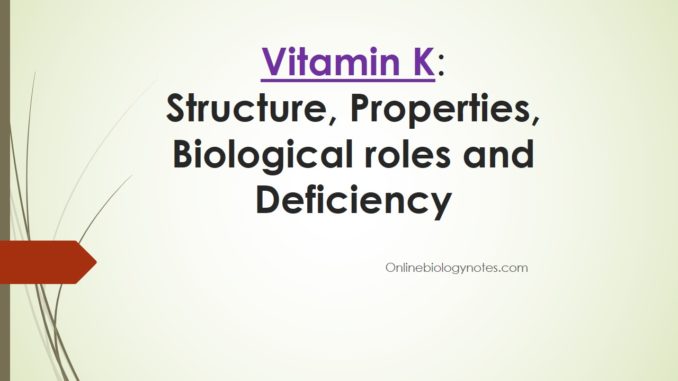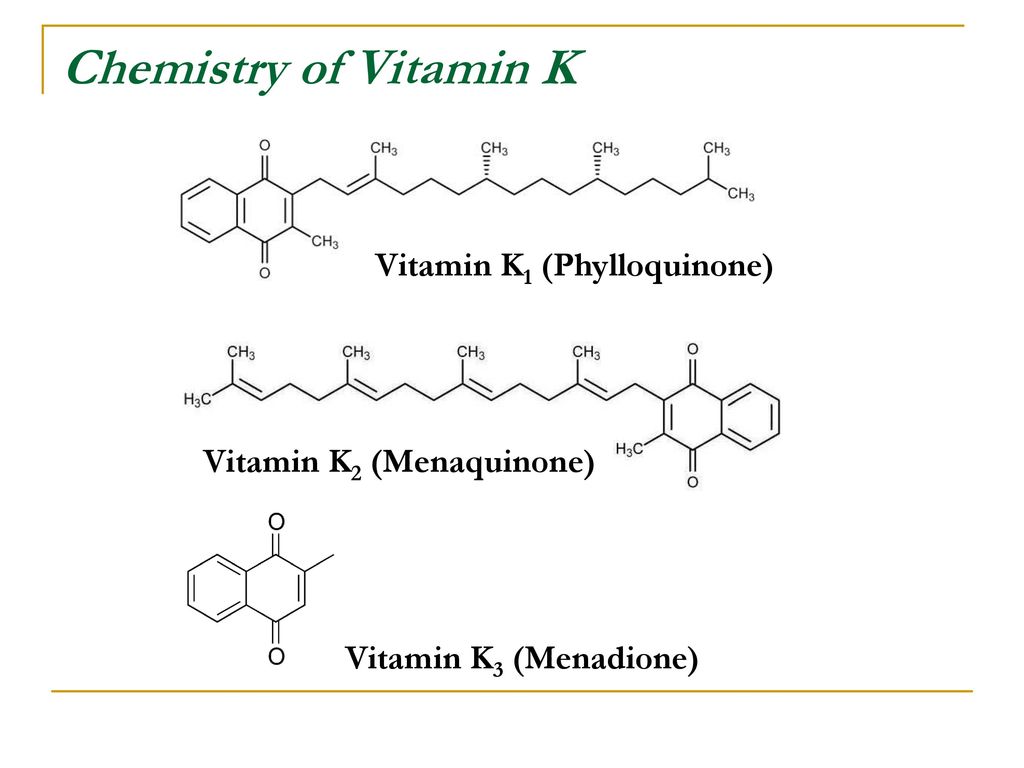
- Fat soluble vitamin that play a major role in post translational modification.
- Vitamin K also acts as a co-enzyme for carboxylase enzyme.
- It is the only vitamin with co-enzyme like activity.
- Vitamin K is absorbed from intestinal tract along with bile salts.
- They are incorporated into chylomicrons and stored in liver, adipose tissue and muscles.
Different forms of vitamin K:
- There are three forms of Vitamin K:
- Phylloquinone (K1)- found in plants
- Menaquinone (K2)- synthesized by bacteria in gut of human
- Menadione (K3)- synthetic form of vit-K provided as medical supplement.
- All these has ubiquinone like structure.

Properties of vitamin K:
- Vitamin K1 is a yellow viscous oil whereas vitamin K2 is a yellowish crystalline solid.
- It is kept in dark bottles as it is sensitive to light.
- It is destroyed by irradiation, strong acids, alkalies and oxidizing agents.
Biological roles of Vitamin K:
- Vitamin k acts as co-enzyme for enzyme carboxylase.
- It catalyzes the carboxylation of inactive precursor of blood clotting factor II, VII, IX and converts them into their active forms.
- II – Prothrombin
- VII – proconvertin
- IX – Christmas factor or Anti-hemophilic factor B
- X- stuart prower factor
- In-active form of these factors contain glutamate residue in their polypeptide chain. Vitamin k catalyzes the carboxylation of glutamate residues at
γ-position forming
γ-carboxyglutamate.
- Polypeptides containing
γ-carboxy glutamate acts as active factors.
- Warfarin and Dicumarol inhibit this carboxylation reaction and therefore act as anti-coagulant.
- Vitamin K also carbohydrates glutamate residues of osteocalcin, a protein found in bones and convert it into its active form.
2. Role of Vitamin K in blood clotting:
- Vitamin K convert glutamate to
-carboxy glutamate.
- γ
-carboxy glutamate has two exposed negative charges.
- This
γ-carboxy glutamate containing blood clotting factor will interact with divalent cation calcium bound to the platelets cell membrane.
- The complex formed is called as prothrombin calcium complex or pro-convertin calcium complex etc.
- This sequence of events leads to the conversion of prothrombin to thrombin.
3. Role of Vitamin K in respiration:
- Dicumarol and warfarin uncouple oxidative phosphorylation (inhibit oxidative phosphorylation).
- Warfarin and dicumarol are also the inhibitor of Vitamin K activity.
- Vitamin K has ubiquinone like structure.
- This fact suggest that vitamin K has role in cellular respiration.
Recommended Daily Allowance (RDA) of Vitamin K:
- The RDA varies from 70-140
g/day.
Dietary source of Vitamin K:
- Cabbage, cauliflower, spinach, alfa-alfa, tomatoes, are good source of vitamin K.
- Vitamin K is also found in eggs, butter, cheese and dairy products.
Vitamin K Deficiency Syndrome:
- Vit-K is widely distributed in nature.
- Therefore vit-K deficiency is rare occurrence.
- Vitamin K deficiency can occur due to consumption of antibiotics which with intestinal bacteria.
- Excessive loss of Vit-K as in diarrheal diseases and due to lack of bile salts, for the absorption of Vitamin K from the intestine.
- Vitamin K deficiency increases the coagulation time.
- This is because of the inactivation of blood clotting factors II, VII, IX and X.
- Profuse bleeding occurs in minor injuries.
- In elderly people and especially in malnourished, a condition called hypoprothrombinemia occurs.
- In child and in infant, excess Vitamin K can result in hemolytic anemia and jaundice.
- This is because of its severe effect on RBC.
- In infants, vitamin K should be supplemented early in their lifetime because they have sterile intestine plus mother’s milk cannot provide sufficient Vitamin K.
- People with severe vit K deficiency also require Vit-K supplement.
- Supplements of Vit-K is allowed along with antibiotics as Cefamandole, moxalactam, and loracarbef.
